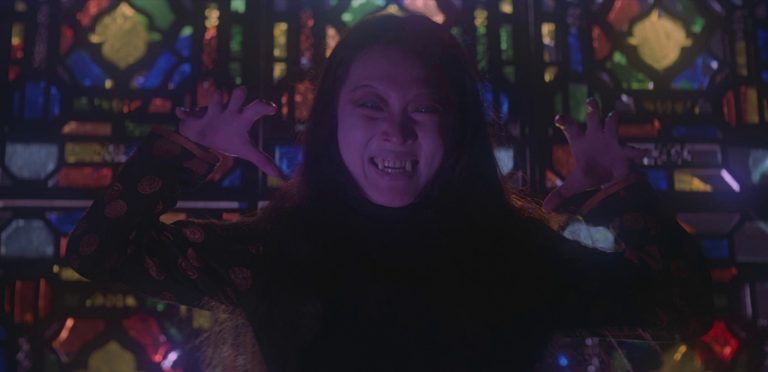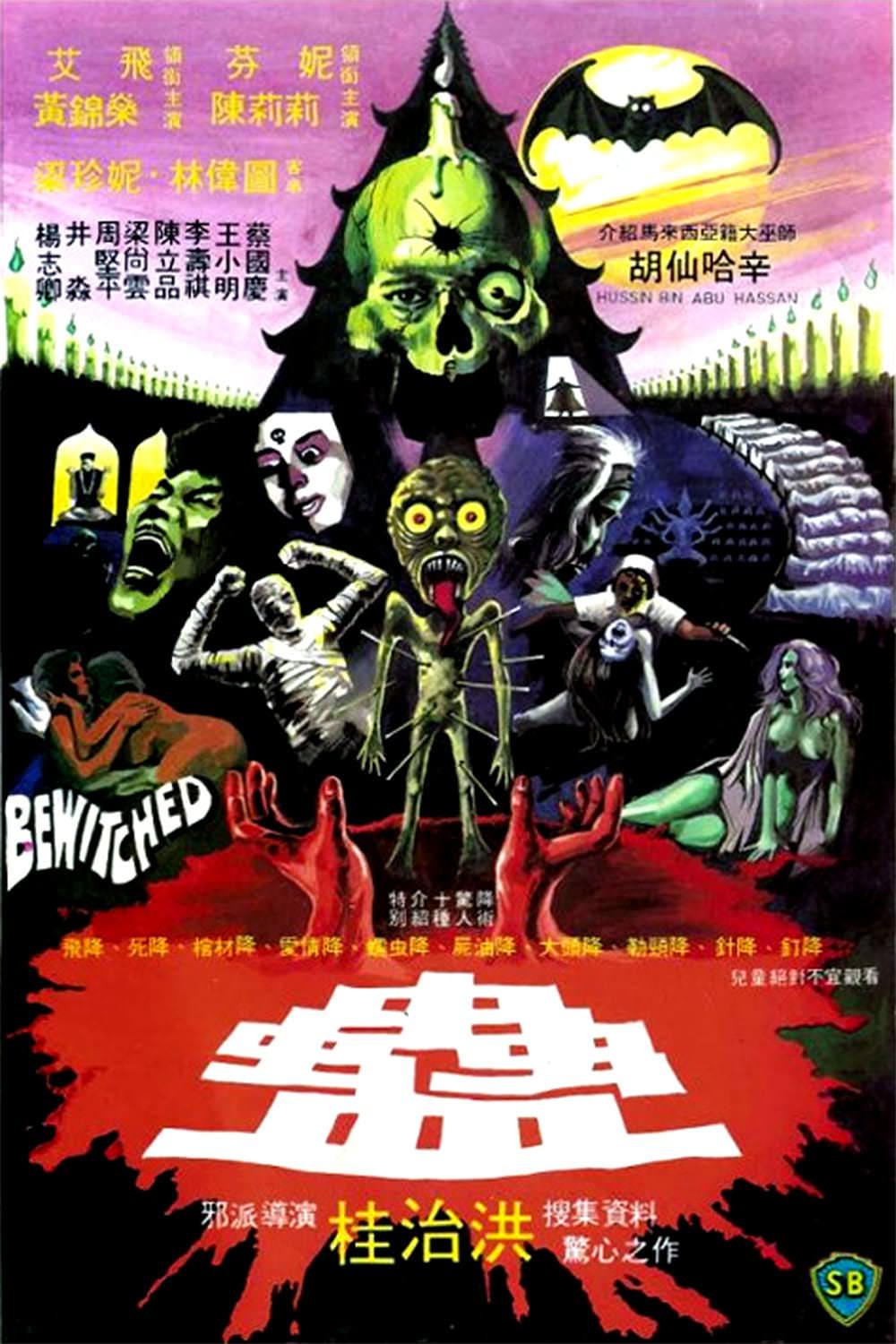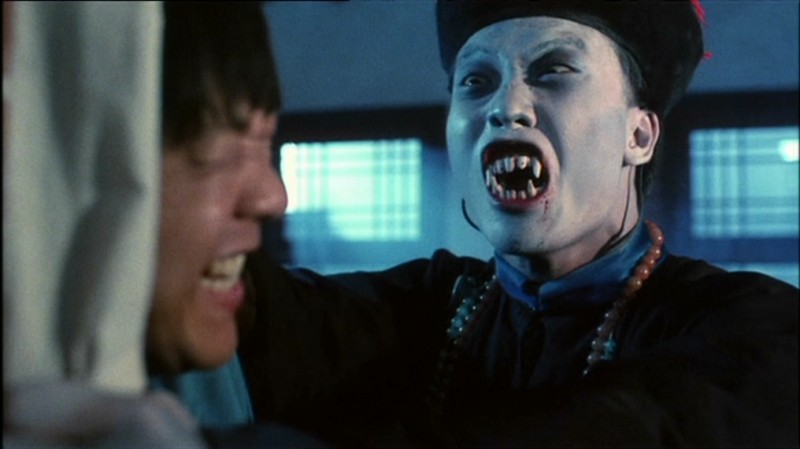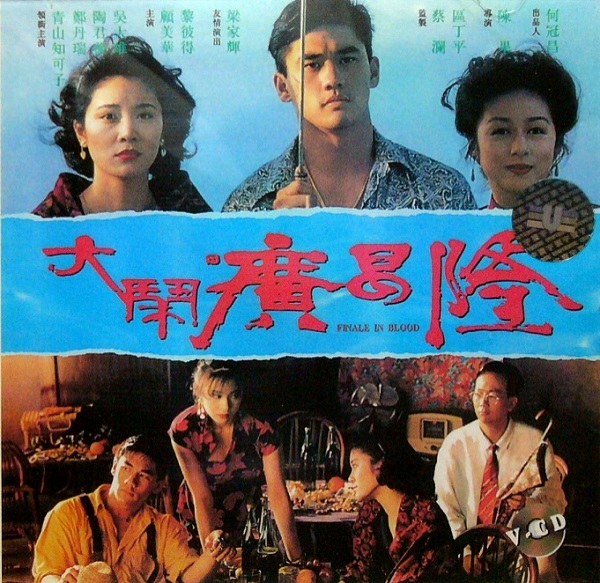Hong Kong Horror Movies: Kung-Fu Vampires and Hopping Corpses
The Golden Age of Hong Kong horror films lasted roughly from the early 1970s until 1997. Here are the most important Hong Kong horror films from that era.

The Golden Age of Hong Kong horror films lasted roughly from the early 1970s until 1997, when the British ceded control of Hong Kong to the People’s Republic of China. Although recorded in the Cantonese language, Hong Kong’s horror films—may of which were produced by the legendary Shaw Brothers Studio, which was a Chinese equivalent of Warner Brothers—proved to be popular throughout the Chinese-speaking world (which mostly speaks Mandarin rather than Cantonese) and the entire Continent of Asia. But then the industry underwent a loss of influence and creativity:
Once celebrated for its strong cultural identity and dynamism, the Hong Kong film industry’s popularity has declined since its prime in the 1980s and the early 1990s. The decline was rooted in various political, economic, and social factors.
The main reason for the decline, though, was political: Once Hong Kong came under partial communist jurisdiction, the former “Hollywood of the Far East” faced increasing censorship, especially when it came to themes of alternative sexuality, political dissidence, and the very idea that ghosts exist.
Chinese filmmaker Jevons Au described the new restrictions in an interview with British newspaper The Guardian:
For us, it is complicated.The uniqueness of Hong Kong is our freedom of speech, of creativity, of expression… [But] to make a co-production with China, you have to follow ever stricter rules.
Since they are recorded in the Cantonese language and originate from a fundamentally different cultural and political climate from that of mainland China, Hong Kong horror films should be considered their own separate genre. Here are the most important horror films from the Hong Kong Golden Age right up to the present.
The Bride From Hell (1972)

One of many productions from Shaw Brothers Studio on this list, The Bride From Hell features a man who enters a country inn one night after escaping ghosts and robbers, only to accidentally chance upon an attractive woman lying nude in bed. Japanese customs dictate that in order to amend for his entirely innocent indiscretion, he is forced to marry the woman. But his relatives notice there’s something strange about the woman—for one thing, a she emits a morbid green glow that her new husband cannot see—and she may be plotting to kill them all.
Legend of the 7 Golden Vampires (1974)

In 1804 in Transylvania, Count Dracula resurrects the seven gold-mask-wearing vampires of Chinese legend. A hundred years later in China, Professor Van Helsing (legendary British horror actor Peter Cushing) is giving a lecture about Chinese vampire legends when seven kung-fu experts beseech his help in rescuing a remote village from the grip of the murderous seven golden vampires. The film wasn’t released in America until 1979 under the title The 7 Brothers Meet Dracula.
Black Magic (1975)

Another offering from Shaw Brothers Studio spotlights an evil magician who lives deep in the forest and casts fatal spells on the objects of people’s unrequited desire. For example, one jealous woman gets him to whip up a potion that makes a man whom she wants all to herself suddenly see his new wife as hideously ugly. But as with all things regarding love, jealousy, and magic, things quickly go dark. A sequel, Black Magic 2, came out in 1976.
The Mighty Peking Man (1977)

Released in Mandarin as Xingxing Wang (Gorilla King), this Shaw Brothers production is a direct but fun-loving ripoff of the King Kong legend made strictly to profit off the success of the 1976 American King Kong remake. On the Indian side of the Himalayan Mountains lives a massive gorilla that filmmakers insist is a yeti named Peking Man. He is accompanied by a gorgeous blonde woman named Samantha who, despite the freezing climes, wears only an animal-skin bikini. Some opportunists take Peking Man and Samantha back to Hong Kong for an ending that is so much like that of the original King Kong that we don’t think we’re spoiling anything by just coming out and saying that it involves a very tall building.
Five Deadly Venoms (1978)

A dying kung-fu master commands his last student to track down and destroy a quintet of martial artists who all have peculiar fighting styles: the Snake, the Scorpion, the Centipede, the Lizard, and the Toad—which are the “five poisonous creatures” of Chinese folklore. The film has been referenced on hip-hop records by Tupac Shakur and Wu-Tang Clan (who helped form an all-female hip-hop group called Five Deadly Venoms), as well as in Quentin Tarantino’s Kill Bill films.
Hex (1980)

A man murders his wife, only to realize that ghosts can’t die. Hex has been compared to many of the British Hammer Horror films of the 1960s and 1970s. According to Silver Emulsion Film Reviews, the film “is ultimately a Hong Kong version of the French classic Diabolique with a bunch of ghost hauntings and the parade of variously colored bodily fluids normally associated with the Hong Kong horror genre.”
Bewitched (1981)

A man becomes possessed by a demon, which leads him to murder his daughter. A police detective investigating the murder also becomes demon-possessed. Then a humble monk rushes in to try to save the day. Diabolik DVD called the film a “sinister and stylish scary movie treat “ that is “more shocking than Friedkin’s The Exorcist and has “some scenic shots of Bangkok and a palpable sense of the Southeast Asian country’s reputation for sex, sin and burning sun.”
Human Lanterns (1982)

In this notorious Shaw Brothers horror classic whose original Cantonese title was Ren pi deng long, a man who has been rendered intensely bitter at humanity after having his face severely disfigured in a kung-fu battle years earlier lives deep in the woods and makes lanterns. He makes them from the skin of beautiful women after peeling it from their bodies while they scream in pain before he finally kills them.
The Boxer’s Omen (1983)
A boxer from Hong Kong travels to Thailand seeking vengeance against a corrupt fighter who crippled his brother. He starts having apparitions of the ghost of a Buddhist monk who eventually reveals he was the man’s twin brother in a past life. From there on out, the Hong Kong boxer is drawn into a world of black magic involving crocodile skulls, monks kept alive in jars, and a laser-beam-shooting Buddha who transforms into a naked gyrating witch. A Shaw Brothers Studios production.
Mr. Vampire (1985)

Released as Hold Your Breath for a Moment in Taiwan, Mr. Vampire was the first in what would become a franchise, with four sequels following from 1986 to 1992. The “vampire” in the film is based on the Chinese legend of the jiangxi, hopping corpses that are sort of halfway between zombies and vampires. According to legend, the jiangxi are controlled by Taoist priests. The film inspired several jiangxi copycat movies until the return of communist censorship ended such movie themes in 1997. Mr. Vampire inspired a 2013 tribute film called Rigor Mortis.
A Chinese Ghost Story (1987)

A combination romance, horror, and comedy film—sort of a unique niche for Hong Kong, and Hong Kong alone—this turned out to be a huge cult hit for young people on the Chinese mainland. It involves a debt collector who falls asleep one night in a temple, not realizing it’s haunted. There he meets a beautiful woman and has sex with her, not caring one bit whether she’s a ghost or not. Then he struggles to help free her from the clutches of an evil tree demon. The BBC referred to the film as a “kung fu Evil Dead romance!”
Men Behind The Sun (1988)
Often cited as one of the most unwatchable films ever made, Men Behind the Sun is an attempt to retell the horrors of Japan’s sinister Unit 731 concentration camp and the brutalities it inflicted upon Chinese and Russian prisoners in World War II. One of the experiments involved tying prisoners to stakes and dropping ceramic bombs around them that were filled with fleas who’d been infected with the bubonic plague. A particularly gruesome scene involves a live cat who appears to be eaten alive in a room filled with rats.
Robo Vampire (1988)

A quickie movie made to capitalize on the massive success of the 1987 American film Robocop, Robo Vampire features a narcotics agent who is shot to death but doesn’t exactly die—due to advances in cybernetics, he is able to live on in the form of a crime-fighting Android. According to The Bloody Pit of Horror, “The very first scene features a pair of American soldiers, Asian drug dealers, snakes, explosions and a hopping (and flipping!) vampire that bites a huge chunk of flesh out of one guy’s neck.”
Dr. Lamb (1992)

Based on the true story of Lam Kor-wan, a Hong Kong serial killer arrested in 1982 for murdering four women, Dr. Lamb is reminiscent of Taxi Driver in that its antihero is a cabbie who feels compelled to rid the streets of all the “filth.” In the process of killing away all the “filth,” he also photographs them in extremely lewd positions before, during, and after mutilating and raping them. As explicit as it is, the film had to undergo several cuts before it could even achieve the most extreme Hong Kong rating, Category III. The Austin Chronicle said, “Dr. Lamb is a slick, and sick, exploitation item that both repels the viewer with its images of disturbing, misogynistic violence, in addition to tickling them with repulsive black humor à la early John Waters.”
Finale in Blood (1993)

Released in Hong Kong as Da nao guang chang long, this, the debut film by legendary Chinese horror director Fruit Chan spotlights a bored man who works at a radio station announcing food prices. His life suddenly becomes far more interesting when he is asked to deliver contraband Western medicine to a man who turns out to be a ghost.
The Eternal Evils of Asia (1995)

A group of friends decide to go have some fun in Thailand, an entire country which is essentially the Las Vegas of Asia. In the midst of their thrill-seeking, they rape and kill a woman. Unfortunately for them, that woman was a sorcerer’s sister. By the time they get back to Hong Kong, they realize the sorcerer has cursed them. Packed with sex and violence, this was another “Category III” boundary-pusher that was rushed in to production shortly before mainland China took over control of the Hong Kong film industry again and clamped down on such extreme subject matter.
Troublesome Night (1997)
This is the first of what would be a staggering 19 films in the Troublesome Night series. It is set in the streets of Hong Kong and features four separate stories that all fold into one another: 1) A group of teens encounters a mysterious grave while on a camping trip; 2) a cheating husband strands his wife alone at dinner on their anniversary; 3) a ghost gives a young girl her first sexual experience; 4) a Hong Kong movie star realizes that the theater where his new movie is premiering is haunted.
Bio Zombie (1998)
In this obvious homage—or ripoff, it depends on one’s perspective—to George A. Romero’s Dawn of the Dead, a pair of young slackers who work at a DVD store must pool their energy to fight off an invasion of blood-hungry zombies who flood their mall in the middle of the day. It turns out that whoever they killed while joyriding and then stuffed in their trunk as they hurried back to work carried some kind of chemical that turns people into zombies.
Naked Weapon (2002)

The evil Madam M hosts a torture camp that puts forty kidnapped 13-year-old girls through such extreme sexual and physical rigors that only three of them will survive. The three survivors then become paid international assassins known as “China Dolls” who earn $1 million a year to seduce and kill male targets. The film was released in Hong Kong as Chik loh dak gung.
The Eye (2002)
Partially based on a true story about a blind girl regaining her sight that the directors, the Pang Brothers, had read about in the news, The Eye (also released as Seeing Ghosts) is a joint Hong Kong-Singaporean production about a female cellist who receives a pair of cornea transplants from a donor. To her dismay, the new eyes also allow her to see ghosts. The film spawned two Pang Brothers sequels, The Eye 2 and The Eye 10, as well as a Hollywood version of The Eye starring Jessica Alba.
Ab-normal Beauty (2004)

A talented but socially alienated art student witnesses a gruesome car crash and feels compelled to take photos of the dead victim. She soon realizes she has an overwhelming and sexual obsession with death. At the moment she realizes she is sick and needs help, someone anonymously sends her a snuff film. She quickly realizes that her obsession is starting to destroy her. Final Girl praised the film’s cinematography: “the Pang Brothers have outdone themselves with regards to style. The film- virtually every frame- is so beautiful that I want to eat it. I wouldn’t even bother with condiments- that’s how delicious it looks.”
Dream Home (2010)
A woman works diligently to save up money to buy her dream condo. But when the sellers reject her offer, she turns to murder, killing 11 people, including two police officers, in the condo building that night. The sellers call her the next day, saying they’re willing to sell to her—but she refuses them, since after all, 11 people got killed in that building the night before.
Keeper of Darkness (2015)

A street-savvy exorcist eschews traditional methods of casting out demons and instead takes a more therapeutic approach: He talks with demons and convinces them to let go of their bitterness. Videos of his exorcisms go viral, which draws the wrath of a murderous demon. Keeper of Darkness was the top-grossing film in Hong Kong on the weekend of its release and was nominated for several Hong Kong Film Awards. South China Morning Post called the film “a welcome touch of deadpan humor.”
Vampire Cleanup Department (2017)
In the midst of performing his duties, a professional vampire hunter makes the shocking discovery that he is part-human/part-vampire himself—or at least maybe he’s immune to vampires? He accidentally meets a beautiful female vampire at the bottom of a lake and falls in love with her. His kiss restores the female vampire’s youth, and he takes her back to his room and tries to ingratiate her into society while desperately trying to prevent her from starting to hop around and in the process reveal to the world that she’s a vampire.
More horror cinema from Hong Kong

Given how big cinema is in Hong Kong, there are naturally dozens and dozens of more horror films to catalog here. Keep reading for more creepy horror movies from Hong Kong.
- Ghost Lovers (1974) is a supernatural drama directed by Shin Sang-Ok. Watch this one for an original twist on traditional ghost-story movies.
- The Flying Guillotine (1975) it might be a stretch, but you could call this a kung-fu horror movie.
- Ghost Eyes (1976) another one from the Shaw Brothers, this is pure nightmare fuel packed with disgusting and violent scenes.
- Die xian (1980) AKA Haunted Tales, features two short films, one involving the ghost of a man who reunites with his wife, the other about a caretaker who makes a deal with dark forces.
- Shaolin vs. Vampire (1980) features a martial-arts warrior who protects baby vampires from all kinds of threats.
- The Imp (1981) a security guard takes a job in a commercial building where people start dropping like flies and soon realizes that a demon is killing them.
- Hell Has No Boundary (1982) a demon-possessed policewoman kills everything in her path.
- Ghost Nursing (1982) by Wilson Tong is a creepy and obscure movie about making strange deals with occult forces.
- Devil Fetus (1983) a demon emerges from a family’s heirloom vase and possesses the dog first, then moves on to family members.
- Night Caller (1985) a cop becomes so deeply involved in tracking a killer that he falls under the killer’s charismatic spell.
- Erotic Ghost Story (1987) is about three fairies that magically take human form and things get erotic.
- The Bride with White Hair (1993) an interesting action adventure film with a cult in it.
- The Eight Immortals Restaurant (1993) an evil killer murders a restaurant owner and assumes ownership. Extremely gory scenes and one sequence where a woman is raped with chopsticks.
- Out of the Dark (1995) is a comedy film involving an inept crew of would-be ghostbusters.
- Ebola Syndrome (1996) is a shockingly offensive, maybe a surreal commentary, but certainly off-kilter movie about a pandemic that takes places in Johannesburg, South Africa.
- Prostitute Killer (2000) a trio of men who are enraged at prostitution’s role in wrecking marriages goes out hunting hookers, who must band together to save themselves.
- Visible Secret (2001) a couple falls in love despite the fact that the woman is the only one who can see all those ghosts and headless corpses.
- Dumplings (2004) a woman makes dumplings that helps reverse the aging process, which seems like a good deal until she reveals the secret ingredient.
- Koma (2004) a bizarre love triangle forms around a woman’s stolen kidney.
- Voodoo (2007) a policeman has an affair with a woman who doesn’t reveal she has magical powers until it’s too late.
- Fairy Tale Killer (2012) a cop investigates a strange series of murders that seem inspired by popular fairy tales.
- The Midnight After (2014) passengers board a minibus for a small vacation and don’t realize they’re being driven to a post-apocalyptic world.